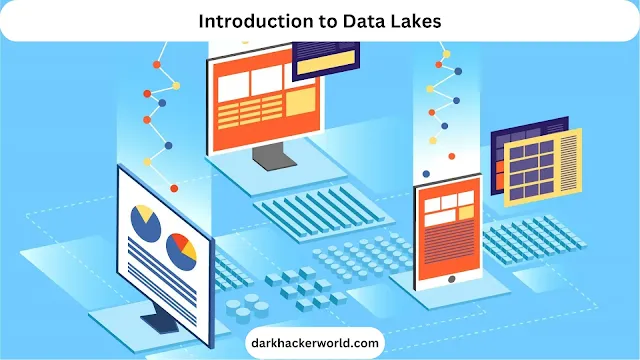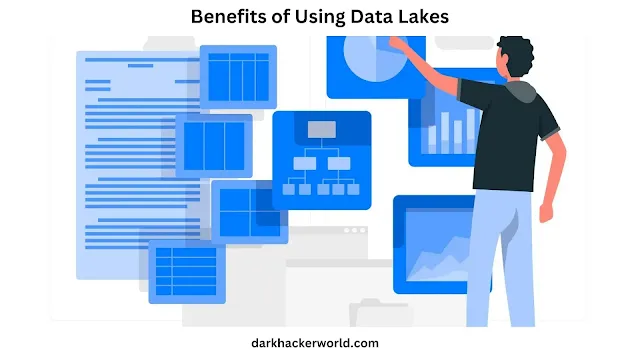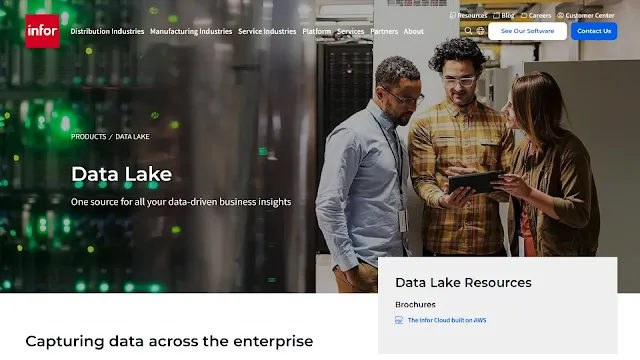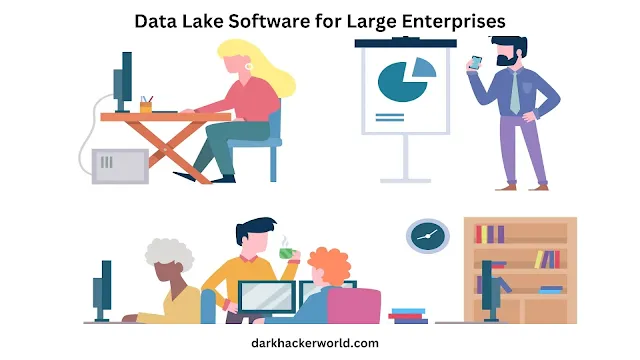The 12 Best Data Lake Tools
Discover the top 10 data lake tools, including Azure Data Lake which can assist you in managing and extracting valuable insights from big data.
Discover the top 10 data lake tools, including Azure Data Lake and AWS Lake Formation, which can assist you in effectively managing and extracting valuable insights from big data.
Introduction to Data Lakes
In the world of data management and analytics, data lakes have emerged as a crucial component for organizations looking to harness the power of big data. But what exactly is a data lake and why is it important?
A data lake is a storage repository that holds vast amounts of raw data in its native format until it is needed. Unlike traditional data warehouses, which require data to be structured and defined before being stored, data lakes allow for the storage of data in its original form. This makes data lakes incredibly flexible and scalable, enabling organizations to store and analyze both structured and unstructured data from a variety of sources.
What is a Data Lake and Why is it Important?
Data lakes are essential because they provide organizations with a centralized and cost-effective solution for storing and analyzing massive amounts of data. By utilizing a data lake, organizations can eliminate the need for costly data transformations and migrations, as well as the need to define schemas up front.
The flexibility of data lakes also allows organizations to capture and store data from a wide array of sources, including social media platforms, IoT devices, and customer interactions. This enables organizations to gain deeper insights and make more informed decisions based on a comprehensive understanding of their data.
Furthermore, data lakes enable organizations to leverage advanced analytics and machine learning algorithms to extract valuable insights from their data. By combining structured and unstructured data, organizations can uncover hidden patterns and correlations that were previously undetectable, leading to improved business outcomes and competitive advantage.
Benefits of Using Data Lakes
There are several key benefits to using data lakes in your organization:
Cost-Effectiveness: Data lakes provide a cost-effective solution for storing and analyzing large volumes of data. With data lakes, organizations can leverage low-cost storage options and scale resources as needed, reducing the overall cost of data management.
Flexibility: Data lakes allow organizations to store data in its original form, without requiring upfront transformations or schema definitions. This provides the flexibility to capture and store diverse types of data, enabling organizations to adapt to changing data requirements.
Agility: Data lakes enable organizations to quickly access and analyze data, empowering them to make timely and informed decisions. By eliminating the need for upfront data transformations, organizations can reduce the time to insight and gain a competitive edge.
Advanced Analytics: Data lakes provide a platform for advanced analytics and machine learning. By combining structured and unstructured data, organizations can unlock valuable insights and drive innovation through predictive and prescriptive analytics.
Key Features to Consider When Choosing a Data Lake Tool
When selecting a data lake tool for your organization, it is important to consider the following key features:
Data Integration: Ensure that the data lake tool supports seamless integration with various data sources, including databases, file systems, and streaming platforms. This will enable you to capture and store data from various sources.
Data Governance and Security: Data governance and security are critical considerations when working with sensitive data. Choose a data lake tool that provides robust security features, such as role-based access control and data encryption, to safeguard your data.
Data Cataloging and Metadata Management: Data cataloging and metadata management capabilities are essential for organizing and understanding your data. Look for a data lake tool that provides robust metadata management features, such as data lineage and data profiling, to enhance data discoverability and usability.
Analytics and Machine Learning Capabilities: Consider the analytics and machine learning capabilities offered by the data lake tool. Look for features such as SQL querying, data visualization, and integration with popular analytics frameworks to enable advanced analytics and data exploration.
Ease of Use and User Experience: Choose a data lake tool that is intuitive and user-friendly. This will ensure that your data teams can easily navigate and utilize the tool, enabling them to focus on extracting insights from the data rather than struggling with complex interfaces.
List of the Top 12 Data Lake Tools
In this section, We will List the top 10 data lake tools for 2023. The following tools have been selected based on their popularity and industry recognition:
1. AWS Lake Formation
AWS Lake Formation is a service that makes it easy to set up a secure data lake in days. It allows you to easily ingest, clean, catalog, secure, and share data in a data lake. Key features include simplified data access and security management, automated data cataloging, data cleansing and classification, and integration with AWS analytics and machine learning services. Lake Formation streamlines the process of aggregating data into a data lake from various sources.
Features:
Data lake creation: Lake Formation can help you create a data lake in a matter of days, rather than weeks or months. It does this by automating the steps involved in creating a data lake, such as creating an Amazon S3 bucket, configuring permissions, and loading data.
Data lake security: Lake Formation provides a centralized way to manage access to your data lake. You can define permissions at the database, table, column, and row levels. You can also use Lake Formation to implement row-level security, which allows you to restrict access to specific rows of data.
Data lake governance: Lake Formation provides a set of tools to help you govern your data lake. These tools include data lineage, which tracks the movement of data through your data lake, and data quality checks, which help you ensure that your data is accurate and complete.
Data lake integration: Lake Formation integrates with a wide range of other AWS services, including Amazon Redshift, Amazon Athena, and Amazon EMR. This integration makes it easy to use your data lake for analytics and machine learning.
2. Azure Data Lake Storage
Azure Data Lake Storage is Microsoft's cloud-based data lake solution. It offers massive scalability and high performance for big data analytics workloads. Data Lake Storage provides unlimited storage capacity and allows you to store data in its native format without needing to first structure the data. It offers file system semantics for compatibility with HDFS along with enterprise-grade security. A key benefit is that it enables you to perform analytics on data at scale and with high concurrency.
Features:
Scalability: ADLS is highly scalable, and can support petabytes of data. It can be scaled up or down to meet the needs of your workload.
Performance: ADLS is a high-performance platform, and can support a wide range of data processing workloads.
Compatibility: ADLS is compatible with a wide range of data processing tools, including Hadoop, Spark, and Hive.
3. Infor Data Lake
Infor Data Lake is a cloud-based data lake platform that helps organizations store, manage, and analyze large amounts of data. It is a fully managed service that provides a unified repository for all of your enterprise data, regardless of its source or format.
Features:
Data ingestion: Infor Data Lake can ingest data from a variety of sources, including relational databases, NoSQL databases, cloud storage, and IoT devices.
Data storage: Infor Data Lake stores data in a variety of formats, including structured, semi-structured, and unstructured.
Data management: Infor Data Lake provides a variety of tools to help you manage your data, including data lineage, data quality checks, and access control.
Data analysis: Infor Data Lake integrates with a variety of analytics tools, making it easy to analyze your data and gain insights.
Data governance: Infor Data Lake provides a variety of features to help you govern your data, including data security, data privacy, and data compliance.
4. Intelligent Data Lake
Intelligent Data Lake is a data lake solution from Informatica that helps organizations discover, prepare, and analyze data from a variety of sources. It is a self-service solution that allows users to explore data without the need for coding or technical expertise.
Features:
Improved data visibility: Intelligent Data Lakes provide a single view of all data, making it easy to see what data is available and how it is being used. This can help to improve data governance and compliance.
Enhanced data analysis: Intelligent Data Lakes make it easier to analyze data, even if it is unstructured or in a variety of formats. This can help organizations to gain insights from their data and make better decisions.
Reduced data silos: Intelligent Data Lakes can help to break down data silos by providing a single view of all data. This can help to improve data sharing and collaboration.
Improved data agility: Intelligent Data Lakes can help organizations to be more agile by making it easy to store, process, and analyze data. This can help organizations to respond to changes in the market more quickly.
5. Qubole
Qubole is a managed big data platform that makes it simple to prepare, integrate, and explore your big data in the cloud. It is an open, simple, and secure platform that supports a variety of open-source frameworks, including Apache Spark, Presto, Hive/Hadoop, TensorFlow, and Airflow.
Features:
Automated cluster management: Qubole automates the installation, configuration, and maintenance of clusters, so you don't have to. This frees you up to focus on your data analysis and insights.
A unified platform: Qubole provides a unified platform for all your big data needs, from data preparation to machine learning. This makes it easy to move data between different stages of the data pipeline, and to collaborate with other users.
A variety of tools: Qubole provides a variety of tools for data exploration, ad-hoc analytics, streaming analytics, and machine learning. This gives you the flexibility to choose the right tool for the job.
Secure and compliant: Qubole is a secure and compliant platform that meets the needs of enterprise customers. It supports a variety of security features, including role-based access control, encryption, and auditing.
6. Google Cloud Storage
Google Cloud Storage (GCS) is a scalable, durable, and highly available object storage service that can be used to store a variety of data, including images, videos, logs, backups, and more. It is a restful web service that is accessible via the GCS API.
Features:
Cost-effectiveness: GCS is a cost-effective storage service. You only pay for the storage that you use.
Ease of use: GCS is easy to use. You can upload and download data using the GCS API or the GCS Console.
Global reach: GCS is available in multiple regions around the world. This means that your data is always accessible, no matter where you are.
7. Snowflake
Snowflake is a cloud-based data warehouse that offers a secure, and easy-to-use platform for data storage and analysis. It is a fully managed service, which means that Snowflake takes care of all the underlying infrastructure, so you can focus on your data.
Features:
Columnar storage: Snowflake stores data in columns, which is more efficient than storing data in rows. This can lead to significant performance improvements, especially for queries that involve aggregations.
Parallel processing: Snowflake uses parallel processing to execute queries, which can further improve performance.
Pay-as-you-go pricing: Snowflake uses a pay-as-you-go pricing model, which means that you only pay for the resources that you use. This can help you to save money on your data warehouse costs.
Global availability: Snowflake is available in multiple regions around the world, which means that your data is always accessible, no matter where you are.
Reduced time to market: Snowflake can help you to reduce the time it takes to get your data warehouse up and running. This is because Snowflake is a fully managed service, so you don't have to worry about provisioning or managing the underlying infrastructure.
8. Databricks
Databricks is a unified analytics platform that combines the power of Apache Spark with enterprise-grade security, governance, and compliance. It is a cloud-based platform that makes it easy to build, deploy, and manage data pipelines and machine learning models.
Features:
Apache Spark: Databricks is built on Apache Spark, a unified analytics engine for large-scale data processing. Spark is a powerful and scalable platform that can be used for a variety of data processing tasks, including batch processing, streaming processing, and machine learning.
Enterprise-grade security: Databricks provides enterprise-grade security features, such as role-based access control, encryption, and auditing. This ensures that your data is secure and compliant with regulations.
Governance: Databricks provides governance features, such as data lineage tracking and auditing. This helps you to track the flow of data through your system and to ensure that your data is compliant with regulations.
Managed infrastructure: Databricks provides a managed infrastructure that takes care of the underlying hardware and software. This frees you up to focus on your data projects.
9. Starburst Data Lakehouse
Starburst Data Lakehouse is a cloud-based data lakehouse platform that combines the power of open-source SQL engines with the flexibility of cloud data lakes. It is a fully managed service that makes it easy to store, analyze, and share data from any source.
Features:
Open source SQL engines: Starburst Data Lakehouse uses open source SQL engines, such as Trino and Presto, to query data in cloud data lakes. This makes it easy to use the tools and skills that you already have.
Cloud data lakes: Starburst Data Lakehouse supports a wide range of cloud data lakes, including Amazon S3, Google Cloud Storage, and Azure Blob Storage. This makes it easy to store your data in the cloud of your choice.
Flexible data access: Starburst Data Lakehouse provides flexible data access through a variety of APIs, including JDBC, ODBC, and REST. This makes it easy to connect to Starburst Data Lakehouse from a variety of tools and applications.
Interoperability: Starburst Data Lakehouse is interoperable with a wide range of data sources, including Hadoop, Hive, Spark, and Amazon S3. This makes it easy to access and analyze your data from a variety of sources.
10. Hevo Data
Hevo Data is a data pipeline platform that helps move data from various sources into data warehouses and data lakes. It offers pre-built integrations and connectors that make it easy to sync data from SaaS applications, databases, streaming sources and more. Hevo handles data transformation, scheduling, orchestration and monitoring of data pipelines. It can replicate data in real-time and also handle incremental data loads. Hevo aims to simplify and automate complex data integration workflows.
Features:
Data merger: Hevo Data can connect to over 150 data sources, including cloud-based applications, SaaS applications, and on-premises databases. This makes it easy to connect to all of your data sources and bring them together in a single location.
ETL/ELT: Hevo Data can perform ETL or ELT on your data. ETL stands for extract, transform, and load, while ELT stands for extract, load, and transform. ETL is a process where data is extracted from a source, transformed into a format that can be loaded into a destination, and then loaded into the destination. ELT is a process where data is extracted from a source, loaded into a destination, and then transformed into a format that is useful for analysis.
Data warehousing: Hevo Data can load data into a variety of data warehouses, including Snowflake, Amazon Redshift, and Google BigQuery. This makes it easy to store your data in a centralized location where it can be easily accessed and analyzed.
Data lake: Hevo Data can also load data into a data lake. A data lake is a repository of raw data that can be stored in its original format. This makes it easy to store large amounts of data and to analyze it using a variety of tools.
11. Fivetran
Fivetran is a data integration solution that replicates data from source applications into destinations like data warehouses, data lakes and databases. It offers pre-built connectors that eliminate engineering work needed to move data. Benefits include automated scheduling, centralized data delivery, configuration instead of coding, and optimization of data transformation. Fivetran manages the entire data integration process and keeps pipelines operational with minimal maintenance. It replicates data changes and loads them incrementally.
Features:
A wide range of connectors: Fivetran has connectors for over 300 data sources, including cloud-based applications, SaaS applications, and on-premises databases. This makes it easy to connect to all of your data sources and bring them together in a single location.
Automated data pipelines: Fivetran's data pipelines are fully automated, so you don't have to worry about writing or maintaining ETL code. This frees up your data engineers to focus on other tasks, such as building data models and creating reports.
Pre-built data models: Fivetran offers a number of pre-built data models for popular data warehouses, such as Snowflake, Amazon Redshift, and Google BigQuery. This makes it easy to get started with data analysis, without having to build your own data models from scratch.
Data lineage: Fivetran tracks the lineage of your data, so you can see where your data came from and how it has been transformed. This makes it easy to audit your data and to troubleshoot problems.
12. Matillion
Matillion is a cloud data integration platform designed to load data into cloud data warehouses and lakes. It includes components for data extraction, transformation, loading, and orchestration. Matillion has pre-built integrations for over 100 different data sources and destinations. It enables code-free ETL with an intuitive graphical interface. Matillion handles mapping data from sources to destinations, transforming data, scheduling, and managing data integration workflows. It is fully managed and automates cloud data warehousing tasks.
Features:
A code-free interface: Matillion's interface is code-free, so you don't have to write any ETL code. This makes it easy to use, even for users with no prior ETL experience.
A visual workflow builder: Matillion's visual workflow builder makes it easy to create and manage data pipelines. You can drag and drop connectors, transformations, and other elements to create a pipeline that meets your specific needs.
Real-time data merger: Matillion can integrate data in real time, so you can access the latest data as soon as it is available. This makes it ideal for businesses that need to make quick decisions based on their data.
Security: Matillion is a secure platform that offers a number of features to protect your data, including role-based access control, data encryption, and auditing.
Data Lake Software for Large Enterprises
Large enterprises often have unique requirements when it comes to data management and analytics. In this section, we will explore data lake software solutions specifically designed for large enterprises. These solutions typically offer advanced features and scalability to meet the demands of large-scale data processing and analytics.
Some of the top data lake software options for large enterprises include:
- AWS Lake Formation
- Azure Data Lake Storage
- Google Cloud Storage
- Fivetran
These solutions offer enterprise-grade features, such as high-performance data ingestion, real-time data processing, and advanced security and governance capabilities. They are designed to handle massive amounts of data and enable large enterprises to derive valuable insights from their data assets.
Data Lake Solutions for Small and Medium-Sized Businesses
Small and medium-sized businesses (SMBs) also stand to benefit from data lake solutions. However, their requirements may differ from those of large enterprises due to resource limitations and budget constraints. In this section, we will explore data lake solutions specifically tailored for SMBs.
Some of the top data lake solutions for SMBs include:
Snowflake Data Cloud: Snowflake is a cloud-based data warehouse that can be used to store and analyze data from a variety of sources. It is a good choice for SMBs because it is scalable and cost-effective.
Amazon Redshift: Amazon Redshift is a cloud-based data warehouse that is similar to Snowflake. It is a good choice for SMBs because it is scalable and cost-effective.
Google BigQuery: Google BigQuery is a cloud-based data warehouse that is similar to Snowflake and Amazon Redshift. It is a good choice for SMBs because it is scalable and cost-effective.
Azure Synapse Analytics: Azure Synapse Analytics is a cloud-based data warehouse that is similar to Snowflake, Amazon Redshift, and Google BigQuery. It is a good choice for SMBs because it is scalable and cost-effective.
These solutions are designed to be cost-effective and easy to use, making them suitable for SMBs with limited resources. They offer essential data lake capabilities, such as data ingestion, storage, and basic analytics, while keeping the complexity and cost to a minimum.
Open-Source Data Lake Tools
Open-source data lake tools have gained significant popularity in recent years due to their flexibility and cost-effectiveness. In this section, we will explore some of the top open-source data lake tools available in the market.
Apache Hadoop: Hadoop is a collection of open-source software utilities that facilitates distributed storage and processing of large datasets across clusters of computers. It is a good choice for data lakes because it is scalable and cost-effective.
Apache Spark: Spark is a unified analytics engine for large-scale data processing. It is faster than Hadoop and can be used for both batch and streaming data processing.
Apache Hive: Hive is a data warehouse infrastructure built on top of Hadoop. It provides a SQL-like interface for querying data stored in Hadoop.
Apache HBase: HBase is a NoSQL database that is designed to be used with Hadoop. It is a good choice for storing large amounts of semi-structured or unstructured data.
Apache Kafka: Kafka is a distributed streaming platform that can be used to collect, store, and process streaming data.
These tools provide a foundation for building scalable and cost-effective data lakes. They offer features such as data ingestion, storage, and processing, and can be customized to fit specific requirements. Open-source data lake tools are particularly suitable for organizations that require complete control over their data infrastructure and have the technical expertise to manage and maintain the tools.
Data Lake Tools for Real-Time Analytics
Real-time analytics has become a critical capability for organizations looking to gain instant insights and make data-driven decisions. In this section, we will explore data lake tools specifically designed for real-time analytics.
Amazon Kinesis: Kinesis is a fully-managed real-time data streaming service that can be used to collect, store, and process streaming data. It is a good choice for real-time analytics because it is scalable and easy to use.
Apache Beam: Beam is a unified model for batch and streaming data processing. It is a good choice for real-time analytics because it can be used to process streaming data in real time or batch data in batches.
Apache Samza: Samza is a distributed stream processing framework that is built on top of Apache Kafka and Apache Hadoop. It is a good choice for real-time analytics because it is scalable and fault-tolerant.
Apache Storm: Storm is a distributed real-time computation system. It is a good choice for real-time analytics because it is scalable and fault-tolerant.
These tools offer features such as real-time data ingestion, stream processing, and low-latency analytics. They enable organizations to analyze and act upon data as it arrives, empowering them to respond to events and trends in real time. Data lake tools for real-time analytics are essential for industries such as finance, e-commerce, and IoT, where timely insights can drive competitive advantage.
Conclusion and Recommendations for Choosing the Right Data Lake Tool
In conclusion, data lakes have become a vital component for organizations seeking to harness the power of big data. By providing a flexible and scalable storage solution, data lakes enable organizations to capture, store, and analyze vast amounts of data from diverse sources.
When selecting a data lake tool, it is crucial to consider factors such as data integration capabilities, scalability, data governance, analytics capabilities, and user experience. Additionally, it is essential to understand your organization's specific requirements and choose a tool that aligns with your goals and resources.
Based on our comparison of the top 10 data lake tools for 2023, the specific needs of large enterprises and SMBs, as well as the popularity of open-source and real-time analytics tools, we recommend evaluating the following options:
- AWS Lake Formation
- Azure Data Lake Storage
- Snowflake Data Cloud
- Apache Spark
- Amazon Kinesis
Remember to consider factors such as your organization's size, budget, technical expertise, and future scalability requirements when making your decision.
By carefully evaluating your options and selecting the right data lake tool, you can unlock the potential of your data and drive innovation and growth in your organization.



















Post a Comment